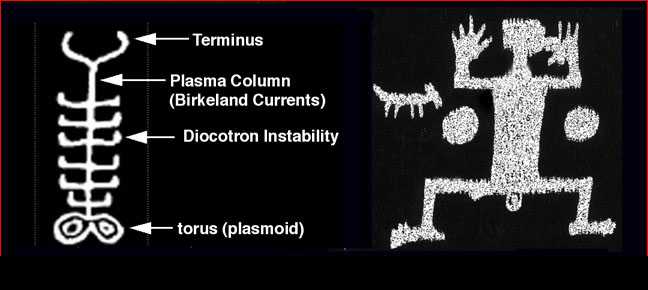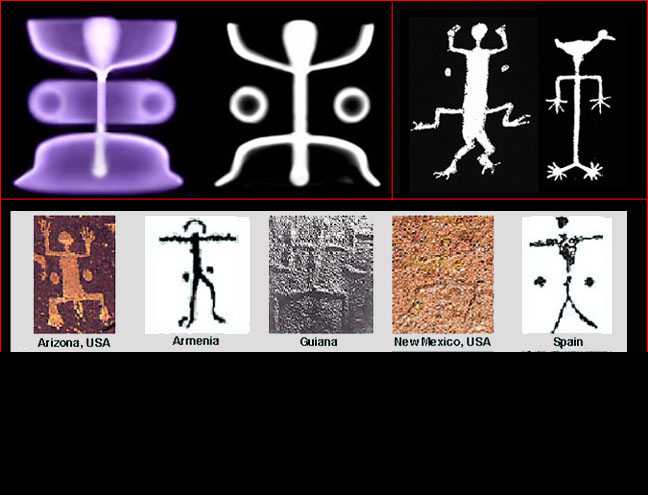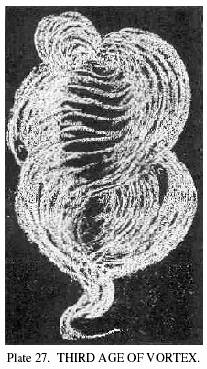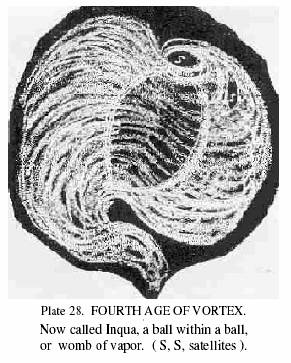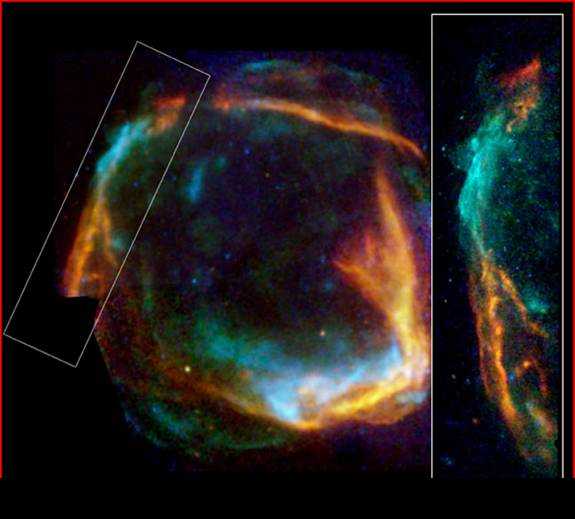Oahspe Study:
Configuration of the Vortex
Both astronomy and research on currents of plasma in laboratory simulations corroborate knowledge of vortices as described in Oahspe, which appeared prior to any of the modern technologies that could prove the existence of the vortex and vortexian currents.
In Oahspe's descriptions of the vortex we learn that all corporeal matter is a manifestion of the action of the vortex, i.e, all matter that comprises the physical universe exists within vortices. Suns and other planetary bodies are condensed out of a seeming vacuum into physically detectable gas and corporeal matter.
The configurations of the vortex at various stages of development are described in Oahspe, Bk of Cosmogony and Prophecy, there are also a number of images of the stages of the vortex. According to Oahspe, knowledge of the vortex is ancient --- people knew about vortices as early as 6,000 years ago.
Current research within the "Electric Universe" model describes
certain patterns in electric currents that are constant, and furthermore, that
such patterns also appear in ancient symbols, pointing to an ancient knowledge
that was preserved in certain symbols.
The following images were extracted from some interesting articles on the
subject of current flow in plasma
and its apparent depiction in ancient petroglyphs (rock carvings) and
pictographs (rock paintings). These configurations also relate to the
configuration of the vortex as Oahspe has revealed it.
|
"Squatter Man" and
|
|
|
|
|
There are similar features in Oahspe's vortex images as those pictured above.
In the two images below, of the third and fourth ages of the vortex (plates 27
and 28), can be seen the same configurations where the head and tail of the
vortex are differentiated by the bulb at the top and the tail's outward then
inward curve at the bottom. The two areas at each side where the satellites
begin to form in plate 27 (the third stage of the vortex), are also clearly
distinguished in Peratt's plasma configurations and those of the ancient rock
art.
|
|
|
|
|
|
||
Book of Cosmogony and Prophecy, 38/3.25-26.
|| Though the general form of a vortex, as already stated, in its beginning is long, then funnel-shaped (like a whirlwind), its ultimate is toward a globular form. And though the current of a vortex is spiral at first, yet its currents ultimate toward less spirality. If one could imagine a very long serpent in spiral form, constantly turning its head in at one pole, and its tail at the other, and continuously crawling upon its own spirality, such a view would somewhat illustrate the currents of a vortex.
In one image [Fourth Age of Vortex] the black center represents a planet, and the black spot with the letter S represents a satellite. The white lines indicate the course of the vortexian currents, but purposely exaggerated in the drawing. First, to show the undulation in the vortex where the satellite rests, and secondly, to show the head turning in at one end, and the bulge of the tail ready to overlap itself, from which there is an excess of light manifested in the tail regions.||
Another aspect of the configuration of the vortex, apparently in the fourth age of maturity, is highlighted in a commentary from the Electrical Universe perspective on a huge nebulous Ourorobos (a circle in the form of a snake consuming its own tail) around a star.
Stellar Ouroboros
||............The image
[below] emphasizes the ring structure around such stars. Because plasma is
composed of some fraction of charged particles, its movement constitutes an
electric current. In fact, space plasmas are generally laced with networks of
filamentary currents. The rings are toroidal circuits coupled to and driven by
the hourglass-shaped current sheets. As such, they are subject to what's called
the "diocotron instability": The current tends to form vortices
along its periphery and to evolve into distorted curlicue shapes. This
phenomenon has been documented in many lab experiments and can be observed in
auroral curtains.......... M. Acheson.|| Extract from Thunderbolts
Archives.
This area of turbulence and condensing nebula at the periphery of a vortex as seen in the spectacular picture (below), validates Oahspe's descriptions of the stages of the vortex of the earth, Oahspe explains that such turbulence around the periphery of the vortex (a wark belt) of the earth formed the moon.
Bk
of Cosmogony and Prophecy, 38/4.14.
|| In the early age of the vortex of the earth, the outer rim flew so swiftly
that border eddies ensued, from which nebula congregated, until the earth had a
nebulous belt around it. This belt, in time, losing pace with the earth's
vortex, condensed and made the moon.||
|
|
|
|
A combined image from the Chandra and XMM-Newton X-ray
observatories
|
Definition of Plasma:
|| Plasma is a form of matter in which many of the
electrons wander around freely among the nuclei of the atoms. Plasma has been
called the fourth state of matter, the other three being solid, liquid, and
gas. Normally, the electrons in a solid, liquid, or gaseous sample of matter
stay with the same atomic nucleus. Some electrons can move from atom to atom if
an electrical current flows in a solid or liquid, but the motion occurs as
short jumps by individual electrons between adjacent nuclei. In a plasma, a
significant number of electrons have such high energy levels that no nucleus
can hold them. An atom that has lost some of its electrons, thereby attaining
an electric charge, is an ion. When a gas is subjected to heat or an electric
field, some of its atoms become ions, and the gas is said to be ionized. An
ionized gas, unlike a gas in its normal condition, can conduct electrical
current to a limited extent. If the heat or electric field becomes extreme,
many of the atoms become ions. The resulting super-ionized gas is a plasma,
which can conduct a large and sustained electric current.|| Extract from
Tech Target.com.
All Oahspe references are from the Standard Edition Oahspe of 2007
●
GO
TO NEXT ARTICLE:
Reincarnation Decoded
